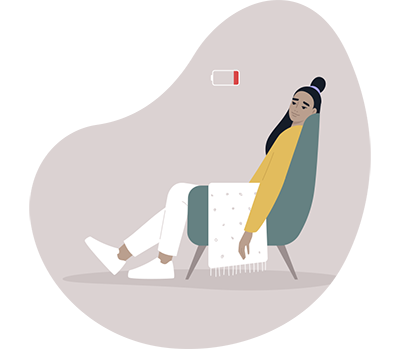
Post-COVID symptoms have a major impact on quality of life (social, personal and professional). Some people with long-term symptoms are unable to resume their normal activities or work because they have fluctuating symptoms of unpredictable duration.
Communication between employers and employees is important to facilitate an adapted return to work, avoiding relapses and potentially long-term disabilities.
Interdisciplinary care is recommended.
These services are currently covered by basic health insurance or, for occupational illness, accident insurance, like any other medical treatment. In addition, some individuals suffering from persistent symptoms causing incapacity in their daily lives have made benefit claims under the invalidity insurance scheme in Switzerland.
Support is essential during this difficult time. We suggest that you to talk to your primary physician to find the best care.
Associations and support groups in Switzerland and the French-speaking world:
Switzerland :
- Altea, the Long COVID Network in English)
- Long COVID Switzerland (in French or German) : Set up by patients on 26 March 2021 in Bern, Switzerland, to advance recognition of long COVID as a disease, research for clinical treatments and to bring support to those affected.
France :
- Association Aprèsj20: French association working to provide information for all audiences, support patients and ensure the joint creation of suitable and consolidated care pathways by health actors and patient partners under #CovidLong and #AvecEtPourLesPatientst.
Return to work
Returning to work with post-acute sequelae of SARS-CoV-2 infection.
Post-COVID and the workplace.
Post-COVID symptoms may persist for weeks or even months, affecting an individual’s functional and work capacity. In our Geneva cohort study, functional impairment was present in 30% of cases 12 months after SARS-CoV-2 infection. With the omicron variant, there was no significant increase of functional impairment compared to the control group (negative SARS-CoV-2 PCR).
Communication between employers and employees is important in facilitating a tailored return to work, to avoid relapses and potentially long-term functional impairment.
Before planning to return to work, you should discuss this with your primary care physician and make sure that you are medically capable of resuming professional activity. Returning to work can be difficult and cause worry and anxiety after a long absence or in people who are still symptomatic. You should discuss it in detail with your primary care physician and your employer to make sure that the employer is aware of your state of health and you can work together on the best possible return-to-work plan for both parties. We recommend regular return-to-work meetings when you are ready to go back to work.

Ergotherapy can help manage the daily activities and give advice and coaching on how to manage tasks.
People with post-COVID symptoms most often have intense fatigue, defined as asthenia. They may wake up tired and spend most of their day with extremely low energy levels. Although they have so little energy and sometimes hardly any at all, that is what they have to use for their daily activities and every aspect of their personal, professional and social lives. If they are overstretched, they may experience post-exertional malaise and need several days to recover. Patients can generally identify a time of day when they have more energy than at other times. It is important for employers and employees to plan the return to work with reduced hours and a lighter workload, and take advantage of the time of day when the employee feels most capable of working. Post-COVID symptoms can also fluctuate and, ideally, employers should review the workload on days when the employee has relapses or major symptoms. In general, symptoms improve over time if the return-to-work framework allows for gradual retraining for work and thus a better recovery. A daily energy diary is available as a tool for patients to monitor their energy levels, examine any improvement and determine when they feel better and which activities use up the most energy.
Individuals with post-COVID symptoms may also have difficulties in concentrating, often described as brain fog. They have trouble doing more than one thing at a time or concentrating for long periods and they may be error-prone. Organization and monotasking can help improve their concentration and their ability to complete their work. There is currently no medication available for post-COVID concentration difficulties. Ergotherapy can help manage the daily activities and give advice and coaching on how to manage tasks.

People suffering from post-COVID symptoms may also experience shortness of breath, chest pain or heart palpitations. These symptoms may occur at rest, but are most often limiting for physical exertion, in which case the workplace should be adapted to reduce the symptoms as much as possible (activity involving low physical effort, more sedentary work).
Organize the working day and the workplace.
The return to work should take place gradually, after realistic short-term goals have been set by agreement between the employer and the employee. In workplaces where it is possible for the employee to be shadowed or assisted, this is the best solution for the first weeks. A gradual return should begin with a small proportion of the usual activity, preferably for half-days or a few hours a day at the time of day when the person has most energy. Single-task projects and work at the beginning, with other tasks delegated to colleagues, may facilitate this gradual return. Scheduled breaks may help the employee maintain energy levels throughout the day and organize the working day. A mixture of remote and on-site working may help the employee by reducing the need for energy for travelling to and from work while promoting reintegration into the team. Return-to-work arrangements (working hours and levels) should allow employees to attend their medical appointments and rehabilitation programmes to improve the chances of long-term improvement in their symptoms. The working environment must be ergonomically adapted to help them conserve their energy (ergonomic adjustment of the workstation: height adjustment, back support, etc.). Sometimes, additional aids such as voice assistance tools can help them conserve their energy (for example, by using dictation).
Take care.
Employers must be made more aware of post-COVID symptoms. These symptoms affect every aspect of life, including the professional sphere, and should be taken into account in adapting the workplace. It is very important to check with the employees concerned and make sure that their activities, place and hours of work are right for their symptoms and allow them to return to work gradually and maintain their functional capacity in the long term. Support groups and focal points can be identified in the workplace to help people with post-COVID symptoms find the right resources. Support groups can also contribute to improving the working environment through employee-employer meetings. Employers can take the opportunity of adapting the workplace for employees suffering from post-COVID symptoms to review the workplace set-up and improve the working environment to help employees maintain their physical and mental energy, which could help avoid long-term absences and resignations.
Long-term disability.
Symptoms generally improve over time after an often slow recovery process. Unfortunately, a small proportion of patients with post-COVID symptoms may not recover enough to be able to return to work. They should be supported through social insurance schemes, with the help of occupational health specialists, human resources departments and their primary care physicians, as well as post-COVID specialists, to determine whether professional reorientation is an option or whether they will require long-term disability benefits.
Online resources containing pacing, breathing, mindfulness, hypnosis and tai chi exercises can improve well-being and manage post-COVID symptoms.


